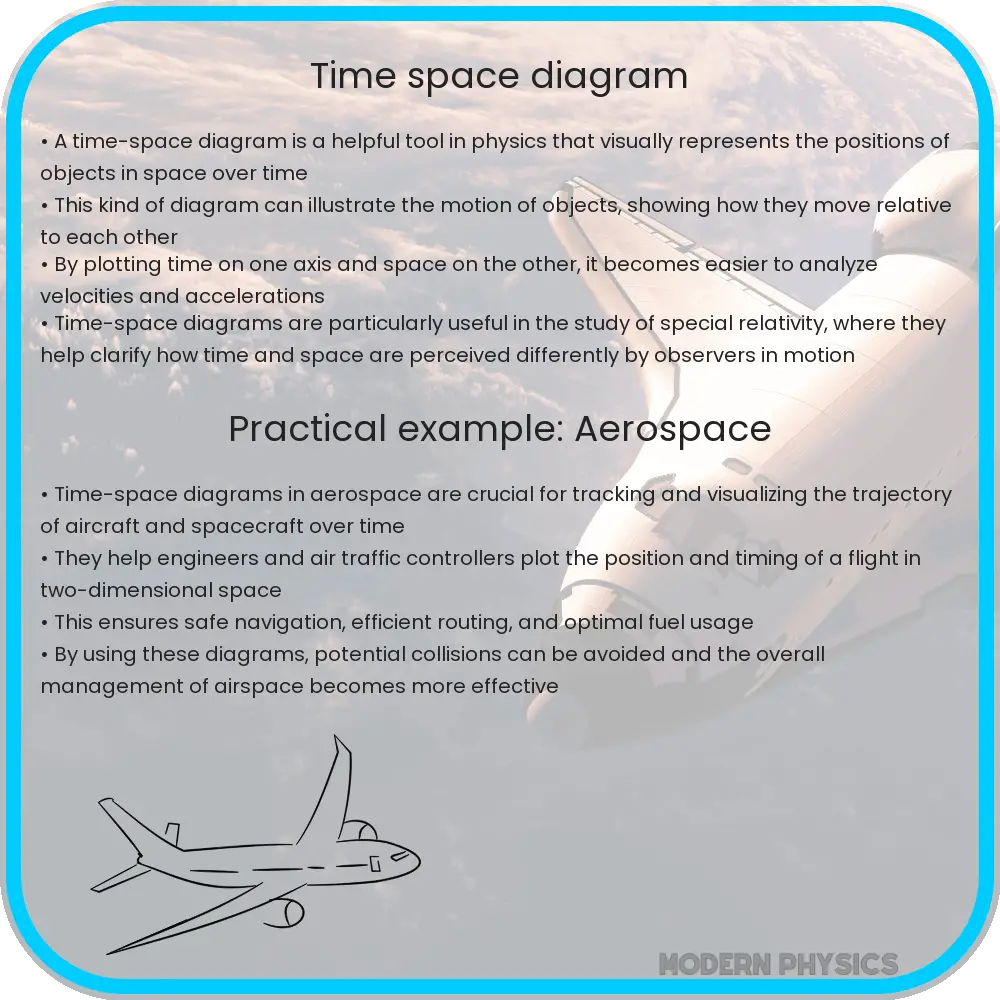Explore the essentials of time-space diagrams in special relativity, understanding time dilation, length contraction, and Lorentz Transformation.

Understanding Time-Space Diagrams in Special Relativity
Special relativity, a fundamental theory established by Albert Einstein, has revolutionized our understanding of space and time. Central to this theory is the concept of space-time, a four-dimensional continuum combining the three dimensions of space with the dimension of time. A powerful tool to visualize and analyze these concepts is the time-space diagram.
Time-space diagrams help in understanding how different observers perceive time and space. These diagrams are not just theoretical constructs; they are practical tools used in physics to represent and analyze events in space-time.
Basics of Time-Space Diagrams
In a time-space diagram:
- Time Axis: The vertical axis represents time. The further up the axis, the later the time.
- Space Axis: The horizontal axis represents space, typically just one dimension of space for simplicity.
- Events: Points on the diagram represent specific events in space-time.
These diagrams become particularly insightful when considering the effects of special relativity, such as time dilation and length contraction.
Time Dilation and Length Contraction
One of the most striking predictions of special relativity is that time and space are not absolute but are relative to the observer’s motion. This leads to phenomena like time dilation and length contraction, elegantly depicted in time-space diagrams.
- Time Dilation: To an observer in motion relative to another, time appears to pass more slowly. On a time-space diagram, this is represented by the tilting of the time axis as velocity increases.
- Length Contraction: Similarly, objects in motion appear shorter in the direction of motion. This is represented by the contraction of spatial intervals on the diagram.
These phenomena are not just theoretical predictions; they have been experimentally verified and have practical implications, such as in GPS satellite technology.
Graphical Analysis of Relative Motion
Time-space diagrams are particularly useful in analyzing scenarios involving relative motion. By plotting the world lines (paths of objects in space-time) of different observers, one can visually analyze how different observers perceive the timing and spacing of events.
For instance, consider two observers moving relative to each other. Their world lines on the diagram would diverge, and the diagram would show how events that are simultaneous for one observer are not for the other. This is the essence of the relativity of simultaneity in special relativity.
Relativity of Simultaneity and Lorentz Transformation
The concept of the relativity of simultaneity is a cornerstone of special relativity and is vividly illustrated in time-space diagrams. According to this principle, two events that are simultaneous for one observer may not be simultaneous for another observer moving relative to the first. This effect becomes more pronounced as the relative velocity between observers approaches the speed of light.
Time-space diagrams also facilitate an understanding of the Lorentz Transformation, the mathematical framework underpinning special relativity. Lorentz transformations describe how, according to observers in different inertial frames, the coordinates of space and time of an event transform. These transformations account for the observed phenomena of time dilation and length contraction and ensure the constancy of the speed of light for all observers, a postulate of special relativity.
Practical Applications and Modern Perspectives
While time-space diagrams are a theoretical tool, they have practical applications. For instance, in the field of astrophysics, they help in understanding the behavior of objects moving at relativistic speeds. In technology, the principles of special relativity, elucidated by these diagrams, are essential in the functioning of GPS satellites and other high-precision timing systems.
Modern perspectives on space-time have evolved from these diagrams. They lay the groundwork for the more complex theories of general relativity and quantum field theory, where the fabric of space-time is not just a passive arena, but dynamically interacts with matter and energy.
Conclusion
Time-space diagrams in the realm of special relativity offer more than just a graphical tool; they provide deep insights into the fundamental nature of the universe. They elegantly demonstrate how time and space are interwoven and relative, depending on the observer’s state of motion. These diagrams not only underpin the theoretical aspects of special relativity but also have profound practical implications in technology and cosmology.
In essence, time-space diagrams serve as a bridge between the abstract concepts of physics and the tangible realities of our universe. As we continue to explore the complexities of the cosmos, these diagrams remain an indispensable tool in the physicist’s arsenal, helping to unravel the mysteries of space and time.
